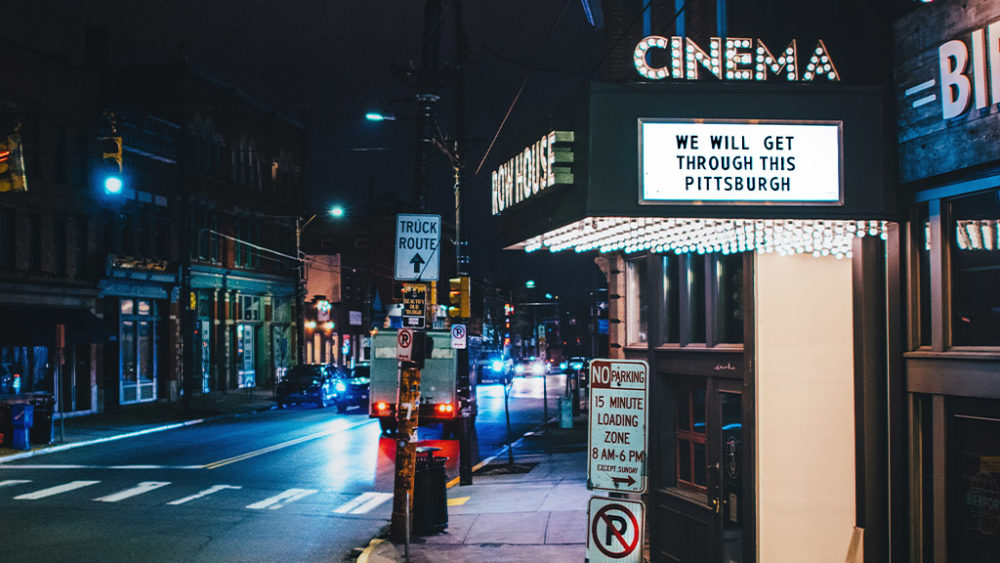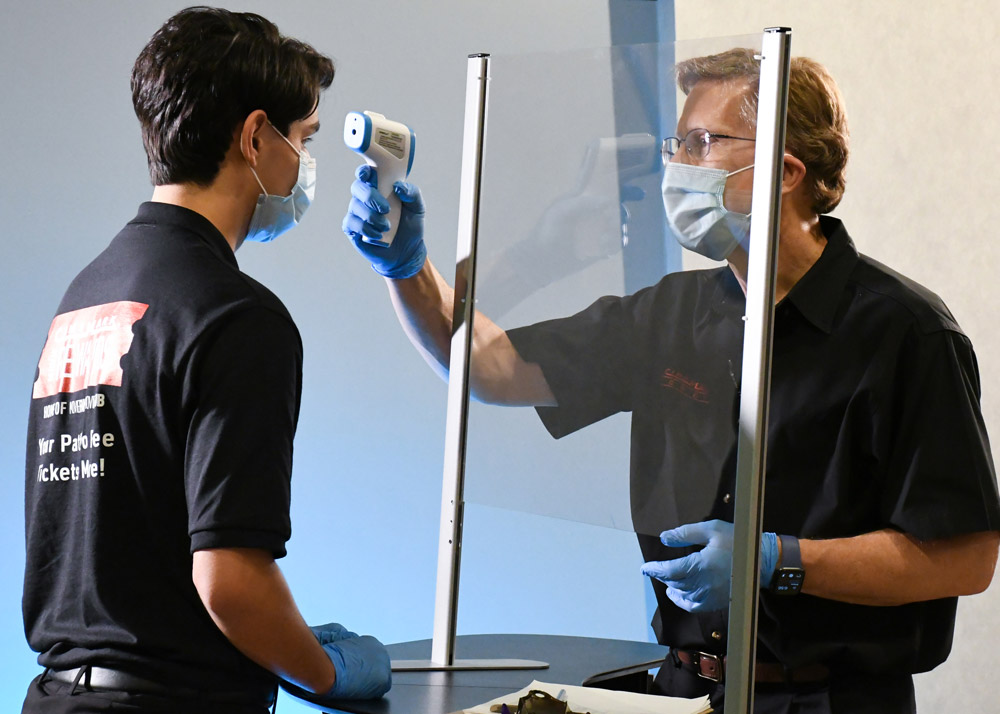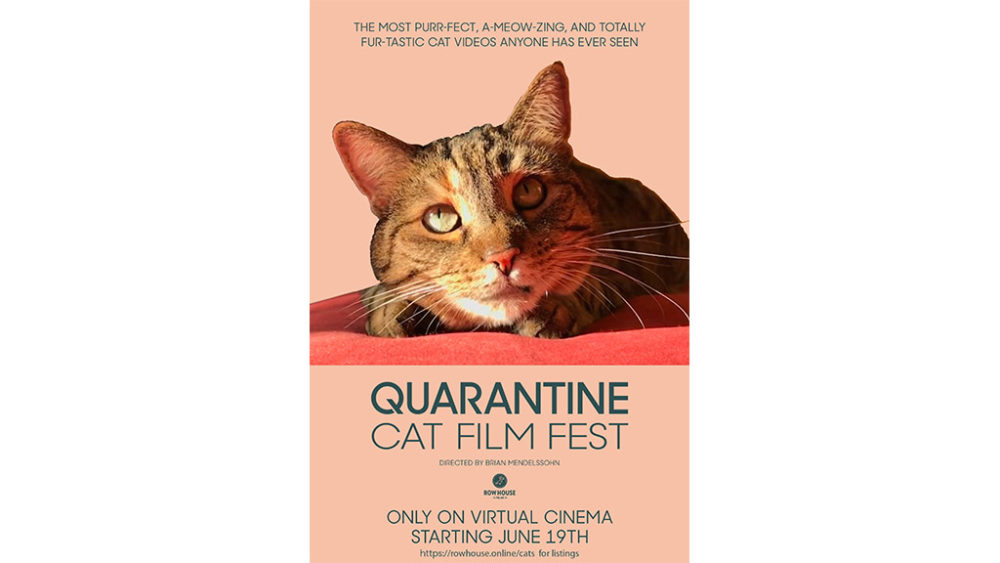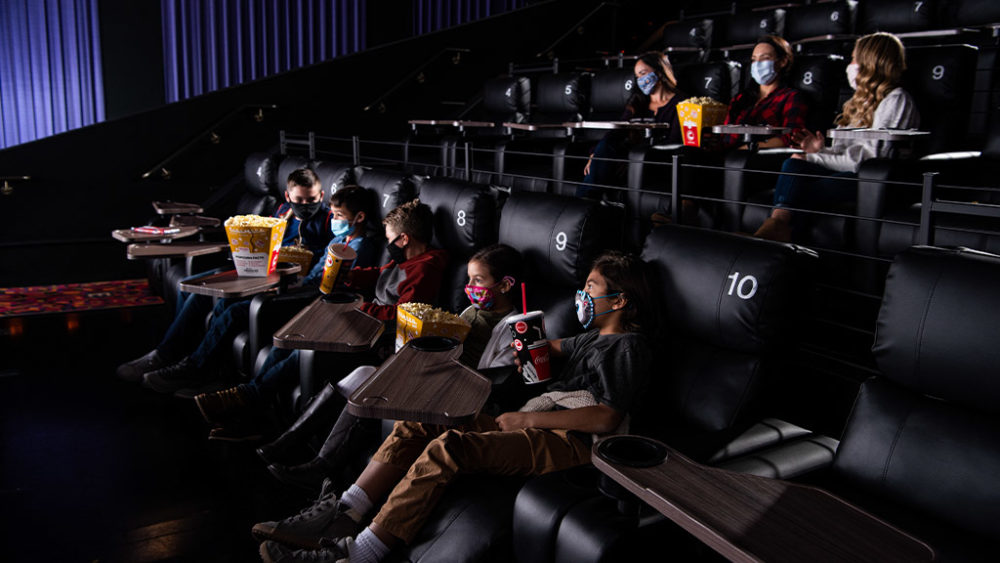
On March 15, 2020, Row House Cinema in Pittsburgh, Pennsylvania shared an image of its marquee on Instagram. But instead of advertising the Pittsburgh Japanese Film Festival that was set to kick off in just five days, the backlit sign featured a six-word message: “We will get through this Pittsburgh.” Along with the image, there was a caption informing the theater’s devoted fans that the venue would be closed for the foreseeable future, due to the worsening COVID-19 pandemic. The Japanese Film Festival would be canceled, but “we will reopen when things go back to normal,” the message promised.
Row House Founder and Owner Brian Mendelssohn didn’t know it at the time, but “back to normal” wouldn’t arrive any time soon. A full year after that original post went live on Instagram, the theater’s doors remain closed — a reality shared by movie theaters across the country, from massive chains to independent icons.
As it did with nearly every industry, the COVID-19 pandemic entirely disrupted movie theaters as — nearly overnight — sitting in a room full of strangers shifted from a normal happenstance to the most highly discouraged activity.
A quick look at IMDb’s Box Office Mojo puts the reality of this disruption in very clear terms: The domestic box office gross for last year clocked in at $2,085,855,696. About 86% of that total came from the first four months of the year, when theaters were almost entirely open. That means U.S. theaters pulled in just under $300 million throughout the remaining nine months of last year — that is less than Avengers: Endgame made in its opening weekend in 2019.
As the pandemic arrived, marquees went dark, studios started pushing all major movie release dates, and theaters were forced to pivot with little-to-no notice. Now, as we head into our second year of pandemic life — with vaccinations starting to roll out — the fate of the movie-going experience is uncertain, yet somewhat optimistic, as theaters continue to adapt.

FADE TO BLACK
Movie theaters, like many other public-facing businesses, have had something of a whiplash experience throughout the pandemic. At first, most states’ regulations required theaters to entirely shut down, but later allowed a partial reopening with extra safety precautions, and have since offered constantly shifting restrictions in response to current COVID-19 statistics.
Some theater chains, like Cinemark and AMC, have reopened in all possible locations, requiring masks, keeping open seats between families within each screening, and implementing aggressive (and highly publicized) cleaning procedures. The other major U.S. theater chain, Regal Cinemas, briefly opened with these regulations in late summer before closing all locations again on Oct. 8 (Regal locations are still closed as of print time).
However, for some independent theaters, like Wellfleet Cinemas in Cape Cod, Massachusetts, reopening with limitations was never the right choice. Owner John Vincent says he could have opened the theater without concessions in late summer, but with no new movies coming out and with the tourist season coming to a close, it wasn’t worth reopening.
Mendelssohn, too, has no plans to reopen Row House Cinema until after the pandemic has passed — even though Pennsylvania technically allowed movie theaters to resume operations in June. “I decided a long time ago that I didn’t want to slowly open the theater and try to fight this,” he says. “We’ve been closed, and we’re gonna stay closed. … The excitement of the movie theater is being able to have an amazing night out, and it’s hard to do that [with restrictions]. And I don’t want to half-ass it.”
THINK OUTSIDE THE BOX OFFICE
Though the rows of vinyl stadium seats inside Row House Cinema have stayed mostly empty for the past year, that doesn’t mean that the theater stopped offering movie experiences for cinema-lovers in Pittsburgh and beyond. Like many small theaters, Row House got creative in its plans, offering curbside concession pickups, virtual cinema screenings (which range from streaming recommendations to a rotating slate of rentals hosted on the Row House website), and even private theater rentals for up to 10 people, which Mendelssohn says sold out in mere hours. These initiatives weren’t without their own challenges, though: For example, right after the theater first opened up reservations for private screenings, Pennsylvania shut down again, and Row House had to refund all of the payments.
“Our biggest fear was, how do we prevent losing the audience that we’ve built?” Mendelssohn says. “So, that was the No. 1 priority, and that was done through all kinds of little things of reminding people that we are a community center for film for them.”

Perhaps the most interesting venture that Mendelssohn and his team took on? The Quarantine Cat Film Festival, which was a virtual event as odd and delightful as the name suggests. After finding some success with virtual cinema, Mendelssohn realized that the theater could profit — and potentially keep some employees on board — if they created their own content.
This idea did present a bit of a problem, as the Row House team is made up of film lovers, not film makers. However, they are also cat lovers who believe that everyone loves few things more than watching cute cats do cute things. So, they partnered with other independent theaters across the country, asking audiences to submit videos of their cats.
Then, they edited more than 1,100 of those videos together into a feature-length film that debuted on June 19 via virtual cinemas in the U.S. and Canada, providing revenue to about 100 local, independent cinemas. It brought in more than $60,000, and Row House Cinema’s cut was enough to keep two employees on payroll through the end of the year.
“It was actually a lot of fun to watch the movie,” Mendelssohn says. “We had fun making it, we had fun doing it. It kind of got our mind off of not being a movie theater for a little while.”
MOVIES: ALFRESCO
In addition to these initiatives, Row House also joined in on a trend that became very popular throughout the summer and fall: opening a drive-in cinema, which held 150 cars in a massive downtown parking lot.
Drive-in theaters dominated much of the movie-going conversation in 2020, with headlines like “How the American Drive-In Staged a Comeback” (Bloomberg) and “The Coronavirus Emptied Movie Theaters. But It’s Resurrecting the Drive-In” (NBC News) painted a very rosy picture of this pandemic-friendly moviegoing option.
According to John Vincent, who owns the Wellfleet Drive-In Theater and Wellfleet Cinemas, and serves as president of the United Drive-In Theatre Owners Association (UDITOA), the situation for drive-ins was a bit more nuanced than headlines made it sound.
“We are happy to be open and happy to serve the customers, but it wasn’t, like, a windfall, gangbusters year for the vast majority of drive-ins,” he explains. Although he frequently emphasizes how grateful he is that drive-ins could be open at all, especially as his indoor theater remained closed, Vincent explains that drive-ins still took a hit because of the pandemic due to two key factors.
First, he says, most drive-ins had to start their seasons late due to the severe lockdowns in the beginning of the pandemic, which kept most drive-ins closed until May or June. This means they lost a month or two of key seasonal revenue. Then, once they were able to open, most drive-ins had to reduce car capacities and shut down features such as playgrounds in order to accommodate social distancing. Wellfleet Drive-In, for example, went from 700 cars to about 300 cars per screening, cutting their revenue by more than half.
“We are happy to be open and happy to serve the customers, but it wasn’t, like, a windfall, gangbusters year for the vast majority of drive-ins.” — John Vincent
The relative safety of drive-in movies also prompted a lot of pop-up drive-ins to open, which wasn’t an entirely welcome development for members of the UDITOA, who dedicate themselves to offering an “authentic drive-in experience.” Many of the members have been in the business for decades — Vincent has been operating Wellfleet Drive-In, which still uses its original speakers from the ’50s, for 33 years.
Vincent says some pop-up drive-ins were better than others, noting that those run by indoor theater owners, who know the industry and understand projection quality, were in a different category from the rest.
“Generally, I didn’t like the ones that were people who had no theatrical experience whatsoever and took a civilian-grade Blu-ray player and put it on a blow-up screen of some sort,” he explains. This year, UDITOA plans to emphasize the authentic experience that only established drive-ins can offer.
MOVIE MERCH MADNESS
While indoor and drive-in theaters are the first businesses you likely think of when considering the impact of the 2020 movie-going experience (or lack thereof), other companies that work with theaters or rely on theatrical releases are an important part of this conversation, too.
Companies that create licensed merchandise inspired by major movies, for example, suddenly lost the traditional interest boost that comes from a theatrical release, as major blockbuster releases were rescheduled multiple times before ending up on a streaming service, like Wonder Woman 1984 (WW84) and Soul. Others were pushed into 2021, like Black Widow and No Time to Die.
Tony Kim, owner of the fandom apparel company Hero Within, says that he saw a direct impact of a delayed movie release on sales of WW84 items. While the movie’s release date changed multiple times, he explains, merchandise can’t shift in the same way, due to manufacturing lead times. Because of this, Hero Within ended up releasing Wonder Woman merch slowly throughout the year, instead of all at once.
“This somewhat diluted the momentum and made it difficult to predict how sales would be during the actual release of WW84,” he says. “Because there wasn’t the shared experience of seeing a movie together with friends, the demand for merch was significantly less this time around. In this new reality, the big question that all online retailers are asking is, can streaming content generate the same merchandise demands as theatrical releases?”

And the answer to that question is yet to be seen, says Todd McFarlane, creator of Spawn and owner of McFarlane Toys. McFarlane Toys also offers merchandise (action figures, specifically) for WW84 and for Warner Bros’ upcoming film Dune, which — like all Warner Bros. titles this year — is slated to stream on HBO Max the same day that it heads to theaters.
McFarlane notes that, in a way, WW84 landing on HBO Max on Christmas Day created a boost for figures that had been available for some time, as fans discovered the context of the hero’s suits after finally seeing the movie. He also says that there aren’t enough examples of streaming-first blockbusters to determine if they can create the same product demand as a theatrical release, but anecdotally he agrees that the long-standing tradition of coordinating product releases with theatrical debuts exists for a good reason.
“The closer you are to the product, the more it’s on people’s minds, right?” McFarlane says. “I’m sure that the NFL sells way more Super Bowl products within the 30-day window around that game than six months away from that game. I think it’s the same for big movies, too. There’s been an impact on everything that’s gotten sort of turned a little bit sideways. It’s far from ideal.”
ONE NIGHT ONLY
Another theater-related business that had to adjust was Fathom Events. A content distributor that is owned by AMC, Cinemark, and Regal, Fathom offers event-based movie experiences to fans around the country. The company presents theatrical screenings of classic movies, arts performances, anime titles, and more. And as theaters closed, opened, and, in some cases, closed again, Fathom had to continuously regroup and shift its offerings — especially considering that their tickets usually go on sale about 30 days before an event.
However, Fathom Events CEO Ray Nutt says that in the final months of 2020, the company was able to provide content to open theaters, something that was certainly needed in the absence of major Hollywood releases. In fact, the company distributed 43 titles in the fourth quarter.
This provided Fathom Events with an opportunity to explore the answer to another industry question: Who is ready to come back to theaters? By testing titles from different content categories, Nutt says they were able to determine which audience demographics were more willing to visit a theater. They discovered that horror and anime audiences, for example, were far more likely to visit a theater, while arts performances (such as The Met Opera screenings) were more sparsely attended, presumably due to an older age demographic.
“It was a real opportunity for us to invest in our company and invest in some opportunity costs to see, alright, going into 2021, what should we be targeting and what shouldn’t we be?” he says. As a result, Nutt says Fathom will treat this year as a rebuilding year, as opposed to a reset. They plan to front-load the year with titles in categories that already have a more willing audience, then incorporate more movies across all categories as the year goes on, slowly building toward pre-COVID levels of content.
COMING SOON TO A THEATER NEAR YOU
Fathom Events primarily utilizes an existing catalog of films for its events, so the company isn’t directly impacted by shifting release dates coming out of Hollywood. But for traditional movie theaters, the ever-changing Hollywood release schedule makes the future of moviegoing hard to predict.
Last spring, as the reality of the pandemic set in and movie theaters all over the U.S. closed their doors, studios started pushing back the release dates for their major films. Disney, Sony Pictures, MGM, and others first pushed back their blockbuster releases by a few months, but when those dates came and went with the pandemic still in full swing, many movies — such as The Batman, Top Gun: Maverick, A Quiet Place Part II, and The Eternals — were pushed into 2021 or 2022.
Studios did eventually release some 2020 titles via streaming or video on demand after initially pushing them back. In some cases, like Mulan, the U.S. release was exclusively digital. For other movies — such as Raya and the Last Dragon and Godzilla vs. Kong — the movies’ digital launches supplemented the limited theatrical release.
Still, when theaters are able to fully reopen, logic dictates that there will be something of a backlog. Films originally set for release in 2021 will have to compete with movies that were originally meant to premiere in 2020, but are rescheduled for 2021.
McFarlane says this backlog may be a good thing, especially for fans. He predicts that, at least for a while, we will see a 12-month cycle of blockbuster releases, without the lulls that usually hit outside of the summer and holidays.
“You know, buffets and McDonald’s and Burger Kings are open every single day. You don’t have to eat there, but they’re always there in case you do want to, right?” he says. “So now, if you’re a fan or a geek and somebody’s saying, ‘Hey, there’s gonna be all these cool movies coming out every month,’ you can decide whether you’re gonna watch them … And we may find in an odd way that spreading it out over 12 months may actually be more beneficial than lumping them right on top of each other during the summer.”

Vincent agrees and says that this wealth of content may be key in getting audiences back to theaters.
“People get in, they like the experience, they see the previews for the upcoming attractions, and they get excited to come back. And it’s a snowball effect,” he says. “The theater-going experience is a momentum-building experience, and I think that having the rich content week-to-week will certainly help and will certainly help bring the industry back on its feet rapidly.”Also, he notes, these blockbuster titles are likely to hit around the same time as the major streaming platforms reach a content lull caused by the significant filming delays and production shutdowns that hit in the early months of the pandemic — which could also push consumers to return to the theater.
SEEKING NORMAL
Of course, perhaps the most pressing — and hardest to answer — questions are if and when audiences will return to the pre-pandemic numbers. While one survey done by market research company Morning Consult last fall found that only 48% of U.S. adults were “likely” or “somewhat likely” to return to a movie theater in 2021, these theater owners seem confident that fans will be back, for a variety of reasons.
To start, as Vincent notes, there is a marked difference in quality when watching a movie in theaters versus at home. Also, he says, watching a movie in theaters removes the many distractions that are present at home, making it easier to enjoy a movie.
“You reach maybe a slow scene, you’re pulling your cell phone up and you’re checking it, where you’re less inclined to do that in a movie theater,” Vincent says. “So you’re more engaged in a movie theater, and that gives you a better experience … and you tend to have a better view of the movie, because you were more into the story, you know? And yes, home theaters are good, but indoor theaters are still better.”
He also highlights the communal experience that movies provide — something that many people have missed throughout the pandemic. Nutt agrees, saying that the desire to go out, once we are able to do so safely, will drive people back to the theaters.
“I do believe there’s going to be enough pent-up interest that the newest and shiniest toy of streaming will still be a thing, but it won’t be as shiny a toy as it was through the pandemic,” Nutt says. “I mean, people want to get out. They’re gonna want to go to ball games, they’re gonna want to go to movies, they’re gonna want to hop on airplanes and go on vacation. All the things that human nature tells us that they want to do, and they will do it.”
“I mean, people want to get out. They’re gonna want to go to ball games, they’re gonna want to go to movies, they’re gonna want to hop on airplanes and go on vacation. All the things that human nature tells us that they want to do, and they will do it.” – Ray Nutt
That ability to have a communal experience is exactly what Mendelssohn and Row House Cinema are waiting for to reopen. Row House Cinema already had an event-focused approach in the six years it has been open, enticing fans to come see classics on the big screen with fellow movie lovers, with programming like “Keanu Reeves Week” (which featured a different Keanu Reeves movie each night, a cardboard cutout of the actor to take pictures with, and an opportunity for audience members to give a speech about why they love the Matrix star).
Mendelssohn already has big plans for the theater’s grand reopening event. There will be hor d’oeuvres, a cocktail hour, live music, and a screening of Pulp Fiction — the movie shown for the original Row House Cinema grand opening.
“We’re going to shut down the whole place for the grand opening and we’re gonna pack it,” he says. “Which is gonna sound crazy. It’s hard to say that. But we’re gonna fill it and we’re gonna sell every seat, and we’re not gonna do it until we’re able to … We’ll delay the opening if we have to, but we’re not gonna do it until we’re able to have every seat full.”
Although he’s willing to delay, Mendelssohn is already selling tickets for this grand reopening, aiming for August or September. Nutt and Vincent are similarly optimistic that the elusive “return to normal” will arrive by the end of this year, especially as vaccines continue to roll out.
Nutt says Fathom Events is projecting that next year will be back on par with 2019 for its content output, while Vincent is hopeful that things will be back as soon as this summer.
“I also think there’s going to be an overwhelming desire to get back in indoor theaters. Just as there will be to get into bars and concerts and the other things that people really miss,” he says. “I think we will have the first-run movies this summer, and I think things will start to return back to normal. That’s an optimistic view, perhaps. Perhaps not.”
This article was original published in Issue No. 9 of the Pop Insider. Click here to read the full issue! Link: https://thepopinsider.com/spring2021
